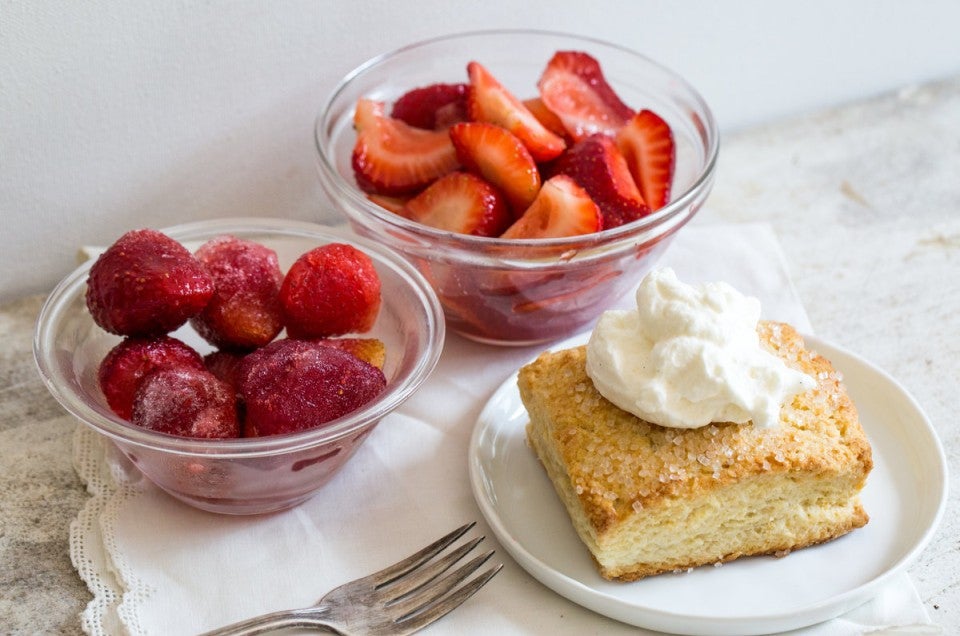


Fresh fruit is a beautiful thing. It brightens the fridge and counter with cheery colors and sweet scents. Frozen fruit allows for some flexibility by extending a typically short shelf life. Both have their place in the kitchen.
But when it's time to whip up muffins, pies, or pancakes, is it OK to use frozen fruit? Does fresh fruit really make that big of a difference? Let's explore some fruity recipes and set a few guidelines for using frozen fruit vs. fresh fruit in baking.

Fruit from the freezer in the grocery store is usually frozen at peak ripeness. Most fruits are about 90% water. When they're frozen, the water in them becomes ice and expands, consequently breaking down the cell structure. When you thaw them out, that lack of structure results in a softer texture.
If you've ever eaten a blueberry or strawberry after it's been frozen and thawed, you'll know they're soft, a little mushy, and have definitely lost the crispness found in fresh berries.
So yes, when it comes to fruit, frozen really is different from fresh. But that doesn't have to hinder your favorite recipes.

If a recipe is going to be baked or cooked after fruit's been added, it's safe to say you can use frozen fruit.
Cakes, muffins, baked fruit pies, quick breads, etc. may require a few small tweaks, but are overall easily adaptable to use whatever fruit you have on hand, be it fresh or frozen.


If whatever you're making doesn't bake or cook for very long, it will help to thaw the fruit first.
For example, making pancakes with still-frozen berries could leave gummy bits of batter around the fruit. The coldness prevents the batter from cooking (without extending the stove time), and the outside of the pancake will likely burn before the inside has finished cooking.
At a minimum, let the fruit thaw. Rinsing and patting it dry will lessen any color bleeding.

If a recipe specifically calls for fresh fruit, it's safe to say that's the ideal way to go — especially if the word "fresh" is in the recipe's title.
Our Berries and Creme Tart or any of the beautiful fresh fruit tarts in our bakery are examples of recipes that need fresh fruit. Using frozen fruit in these, thawed or not, will produce a lot of juice. The juice will make your crust soggy, and the soft, mushy fruit won't be nearly as attractive.
If you just can't wait to make a fruit tart and only have frozen fruit on hand, try a baked recipe like a galette or our Rustic Peach Tart.

Our Fresh Raspberry Pie recipe calls for 1 1/2 quarts of fresh raspberries. I had to know if the berries being fresh really made a difference because it called for such a large amount.
The verdict? BIG difference.
The pie made with frozen berries was noticeably darker in color and lacked texture. Eating this felt like eating a slice of raspberry jam. It also had a hint of that notorious "freezer flavor."
Lesson learned! If "fresh" is in a recipe's name, I recommend following it and saving your frozen fruit for something else.

Some of our most popular and well-loved recipes include fruit as a topping. One delicious example is Strawberry Shortcake. While using thawed, frozen strawberries to top shortcake wouldn't be the end of the world, the texture would be lost.

Because this recipe only has a few simple components — shortcake, whipped cream, and berries — the texture of each component plays a huge role in the overall success of the dish.
If you use thawed, frozen raspberries for the filling in a cake, such as our Chocolate Mousse Cake with Raspberries, the juices will bleed into the frosting and filling, making them watery. Juice can also potentially cause some of the frosting to slide off. While still flavorful, the cake won't have the intended clean, attractive look.
Using thawed, frozen fruit in an unbaked dessert will yield mushy texture, making the dessert less enjoyable. If you can find fresh, use it.


The next time there's a muffin emergency and you only have frozen blueberries on hand, there's no need to fret. Frozen fruits will suffice in most fruity recipes.
If you're still unsure, give the Baker's Hotline a call to double check if using frozen fruit would be a problem in your recipe.
What are some of your favorite fruit-centric, year-round treats? Let us know in comments, below.
Thank you to Anne Mientka for taking the photos for this post.

